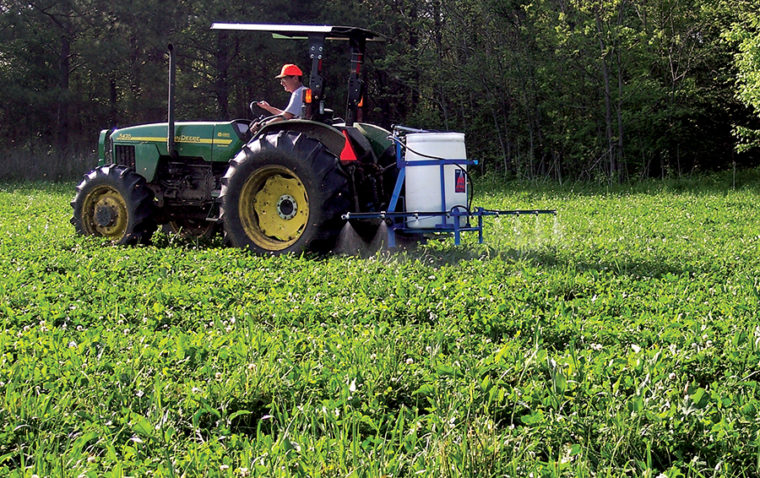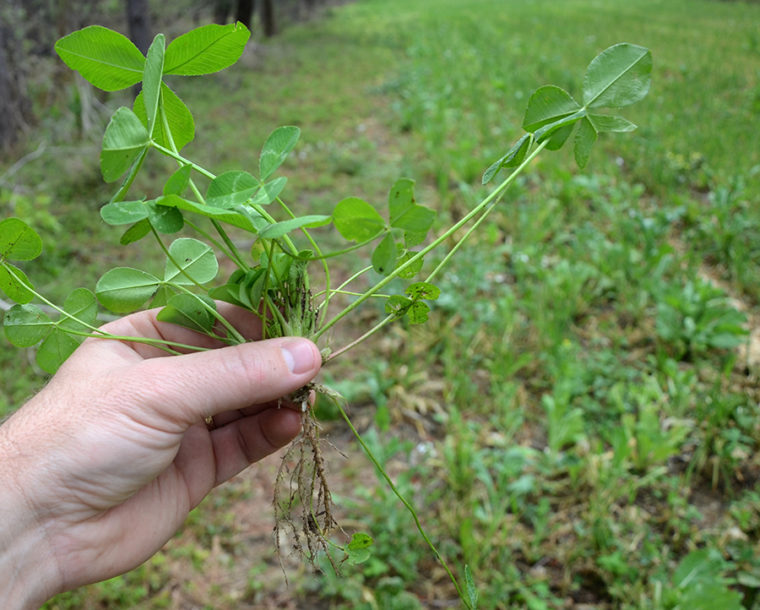One of the most basic characteristics of a deer forage that essentially lays the foundation of a food plot program is the time of year it is available and how long it lasts. When you understand the differences between annual and perennial forages, you’ll be better able to decide which is best and most cost-effective for your needs, your soil types and the nutritional deficiencies of the deer habitat where you hunt.
Separating Annuals From Perennials
Annual forages behave just as the name implies. They germinate from seed, grow for several months, produce new seed, and then die in less than one year. Some examples of annual forages include the cereal grains – wheat, oats, rye, triticale – crimson clover, arrowleaf clover, berseem clover, balansa clover, rape, kale, turnips, Austrian winter peas, soybeans, corn, and cowpeas. There are many others, but these are some of the more common species planted for deer.
Some examples of perennial forages that are commonly planted for deer include various white clovers, red clover, alsike clover, alfalfa and chicory.
Note the annual growth characteristic is not based on a calendar year, however. For example, among the annual species listed above, some are planted in the spring for warm-season production while others are planted in the fall for the cool season. Those planted in the spring or early summer will grow and persist through the summer and fall but will be killed by a hard frost the same calendar year, thus providing forage for roughly four to six months or more depending on the species planted and the length of the growing season where you are located. Conversely, the cool-season annual forages that are planted in the fall will grow through the fall, winter and spring and then die the following summer. Although the cool-season annuals span across two calendar years, the total life span of the forage is less than one full year.
Perennial forages are different from annuals because they will continue to grow from an established root system for more than one year. Perennials typically persist for two or more years, depending on the species along with a variety of factors that influence growth and longevity, such as geographic location, soil type, weather, insects, disease, deer browsing pressure and so on. Some examples of perennial forages that are commonly planted for deer include various white clovers, red clover, alsike clover, alfalfa and chicory.
Advantages and Disadvantages
From a deer management and hunting perspective, there are advantages and disadvantages of annuals and perennials. The time of year that quality forage is available for annual and perennial forages is very different and should weigh heavily on the management strategy for your hunting land.
For example, annual forages typically provide more quality forage during the two primary stress periods for deer, which occur during late summer and late winter and are associated with low natural food availability. Late winter is also associated with post-rut recovery. Thus, warm-season annuals provide more forage during the late summer stress period while cool-season annuals provide more forage during the late-winter stress period. There is not an annual forage that satisfies both stress periods with a single planting with the exception of soybeans, where the soybean forage can be used by deer in late summer and the standing soybean grain can be used in late winter if it is still available.
Annuals typically provide more quality forage during the two primary stress periods for deer, which occur during late summer and late winter and are associated with low natural food availability.
Conversely, forage availability from perennial species is typically greatest during the spring and summer, which is an important season for growth and development for whitetails. However, depending on the geographic location of your property, some perennial species may produce little to no forage during the late-summer or late-winter stress periods. This is an important consideration if you are trying to fill specific nutritional gaps or developing productive plots to hunt over.
For example, if your hunting area is in the northern two-thirds of the U.S. or Canada, don’t expect to be able to hunt over perennial forages during winter as the onset of cold weather will cause these species to go dormant and be unproductive until spring. On the other hand, if your hunting area is in the Deep South where the weather often gets hot and dry during summer, don’t expect to have lush perennial clover available during the late-summer stress period to provide quality nutrition for antler growth and lactation. Perennial clover simply can’t withstand hot, dry conditions and will go dormant or even die out during this time. Thus, considering these two scenarios, annual crops would be more important to have in order to satisfy these objectives.
Which is Most Cost-Effective?
Another common comparison among annual and perennial crops is the overall costs associated with planting and maintenance. Because perennials often persist over the course of several years, many food plotters assume they cost less than annuals in the long run and require less labor for maintenance. However, when considering all the costs and steps needed to achieve optimal forage availability from perennial species throughout a given year, this may not be the case.

Some food-plotters assume perennial forages involve less work because they last longer. However, they only last as long as you control weeds and maintain soil nutrients, which means work.
There are many variables that influence the costs associated with managing annual and perennial plots. While the methods used to plant annual and perennial plots are similar, follow-up management activities will differ among these forage types. Seed cost may be cheaper for some perennial forages because less seed is needed per acre. However, perennial plots often require multiple trips to the field during the summer to spray or mow weed competition. Summer annual plots typically only need one herbicide treatment if any after planting, and mowing isn’t necessary, thus saving time and money.
Additionally, perennial plots will typically need to be fertilized in spring and fall for optimal production, whereas summer and fall annual crops would be fertilized once per year. Another consideration is the time you have to devote toward managing your plots. If you lack the time needed to manage your perennial plots throughout the summer as needed, annual plots may be better suited for you since they typically require less maintenance.
As you can see, there are many variables to consider – seed, fertilizer, herbicide, fuel, equipment, number of visits to the plots needed to manage properly – when determining which strategy is most cost effective for you or best suits your schedule.
Conclusion
Unfortunately there isn’t a one-size-fits-all application for deer hunters when it comes to managing food plots on a given area. Each tract of land is unique and presents different challenges. This is why it is important to identify the most limiting factors in your area from a nutrition standpoint and develop an effective plan to address them. A combination of both annual and perennial forages is often needed to fill these voids, and determining the best ratio of annual to perennial plots can be accomplished with a little practice and patience.
